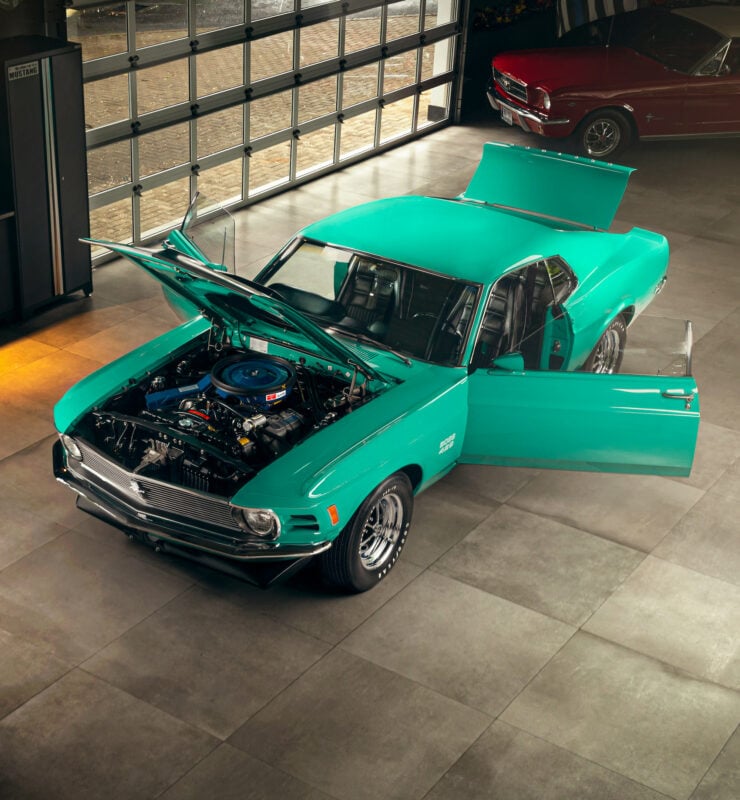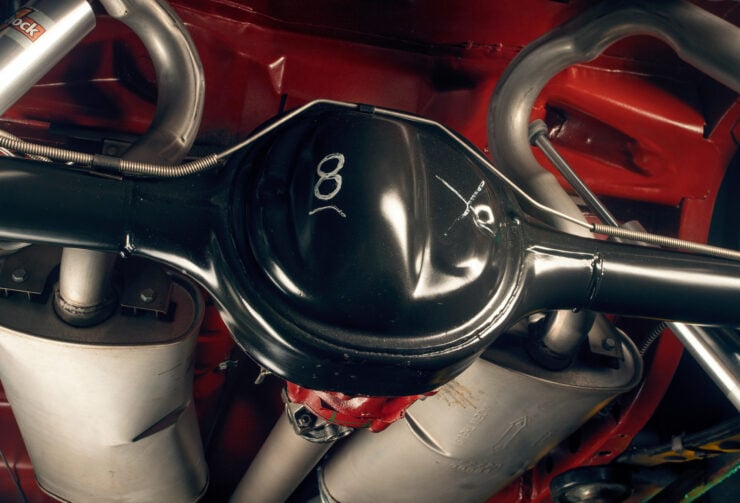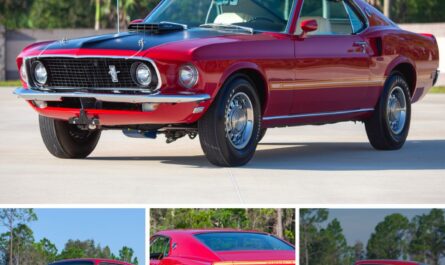The Ford Mustang Boss 429 was famously created to homologate the big block 7.0 liter Ford V8 for NASCAR racing. It was the largest engine ever fitted to a Mustang – capable of 375 bhp, the same output as the Ferrari Testarossa which wouldn’t debut for another 15 years.

The Boss 429 would only be made for 1969 and 1970 before being discontinued, with just 1,359 made over this two year production run. Today they remain one of the most collectible muscle cars ever made.
Fast Facts – The Ford Mustang Boss 429
The Ford Mustang Boss 429 was developed specifically to homologate the 7.0 liter 429 cubic inch V8 for racing in NASCAR. 500 examples needed to be manufactured and sold in order to meet the minimum requirement.
The big block 429 V8 was too large to fit in the Mustang engine bay, so significant work was done at Ford and at Kar Kraft (Ford’s exclusive experimental facility) to make it fit, and to develop it into a production car.
A range of changes were made both to the engine and to the car to make the Boss 429 project a reality. It was ultimately a success and the model went on sale in 1969, then left production after 1970.
The car you see here is one of just 52 that were made in Grabber Green. It’s now accompanied by its NASCAR production number decals, owner’s manuals, and an Elite Marti Report. It’s due to cross the auction block with RM Sotheby’s on the 26th of January with a price guide starting at $275,000 USD.
The “Boss” Ford Mustangs
The Boss Mustangs consisted of three individual models, the Boss 302, Boss 351, and Boss 429. The first was the Boss 302 which had been developed to homologate the car for the SCCA Trans-Am championship. The Boss 429 was developed to homologate the larger 7.0 liter engine for NASCAR competition, and the Boss 351 was developed as a special high-performance model for 1971.

As the story goes, the name “Boss” was chosen almost by accident, President of Ford Semon “Bunkie” Knudson had hired Larry Shinoda away from GM to head up the new program. When Shinoda was developing the Boss 302 it was a secret project, so when anyone asked what he was working on he would smile wryly and say “the boss’s car,” referring to Knudson.
Though originally the project was only intended to produce one car, the Trans Am eligible 302, it was eventually expanded to include the three that were made in total. Ford also capitalized on the Boss Mustangs to bring the performance Mustang brand back under 100% Ford labelling and away from the Shelby brand.
The Ford Mustang Boss 429
When it was decided to homologate the 429 cubic inch big block V8 for NASCAR completion the most obvious thing to do was build a production example based on the Mustang – a car already well-known in the United States for its successes on track in the Shelby program earlier in the 1960s.


Ford conservatively claimed that the engine made 375 bhp at 5,600 rpm and 450 lb ft of torque at 3,400 rpm.
The problem was that the Mustang’s engine bay was too small to fit the engine. This problem was shifted away from Ford to Kar Kraft – Ford’s exclusive high performance car division that had already proven their mettle further developing the 24 Hours of Le Mans-winning Ford GT40.
The inner section of the engine bay had to be widened to accommodate the larger engine, but the additional weight of the larger big block resulted in adverse handling – even with aluminum heads added to reduce weight.
To claw back some better weight distribution the battery was moved to the trunk, and a rear sway bar was added to help improve handling further. The team at Kar Kraft moved the front shock absorber towers 1″ forwards and the A-arms were modified to lower the front of the car by an inch.
A functional hood scoop was added up top, it remains the largest hood scoop ever used on a Mustang production car to date. A Boss-style black chin spoiler was added as was an optional rear spoiler on the deck lid.


Inside the car there were very few clues as to the fact it was a Boss 429, with the exception of the oversized hood scoop in front of you that is.
The overt styling of the earlier Boss 302 wasn’t used on the 429, the styling was much more understated with just a discreet “Boss 429” decal on each side to denote what you were looking at.
The Boss 429 V8 came with a single Holley four-barrel carburetor (rated at 735 CFM) mounted to an aluminum intake manifold that had been chosen to help reduce weight. Tubular headers were also used for better flow and lower weight than the cast iron units.
Inside the engine you’d find four-bolt main caps, a forged steel crankshaft, forged steel connecting rods, semi-hemispherical combustion chambers, and either a a hydraulic lifter camshaft (used in 1969) or a solid lifter camshaft (in 1970).
Power output was impressive, Ford claimed 375 bhp at 5,600 rpm and 450 lb ft of torque at 3,400 rpm, but some estimates have put the real horsepower figures closer to 500 bhp. Just 1,359 would be made due to limited demand at the time, but today they’re considered highly collectible.


The “Boss” graphics were toned way down on the 429 compared to the earlier 302, with just discreet side decals used.
The 1970 Ford Mustang Boss 429 Shown Here
The car you see here is one of just 52 that were made in Grabber Green, a color that suits the car and its black accents remarkably well.
When new this 429 was optioned with the Drag Pack and competition suspension, and it’s accompanied by original dealer invoice, a carburetor tag, NASCAR production number decals, owner’s manuals, and an Elite Marti Report.
It’s now due to be auctioned by RM Sotheby’s on the 26th of January in Phoenix, Arizona with a price guide of $275,000 – $350,000 USD. If you’d like to read more about it or register to bid you can visit the listing here.













